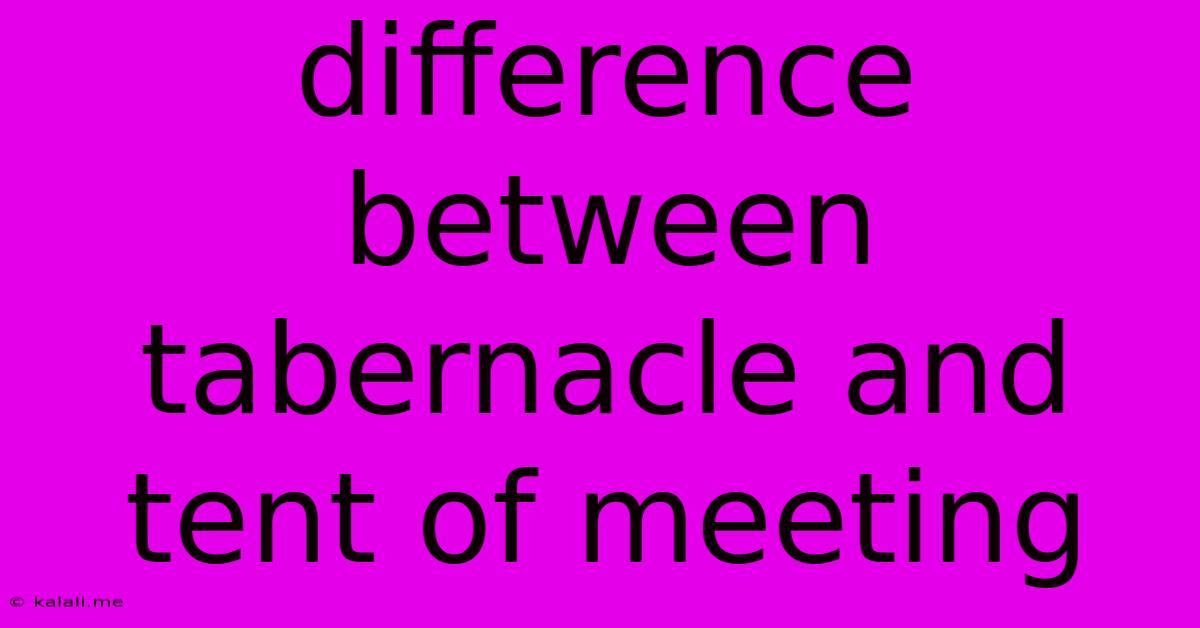Difference Between Tabernacle And Tent Of Meeting
Kalali
May 29, 2025 · 3 min read

Table of Contents
Tabernacle vs. Tent of Meeting: Unveiling the Distinctions
The terms "Tabernacle" and "Tent of Meeting" are often used interchangeably, leading to confusion about their true meanings within the context of the Old Testament. While closely related, these terms represent distinct aspects of the same sacred structure used by the Israelites during their wilderness wanderings. This article clarifies the key differences between the Tabernacle and the Tent of Meeting, shedding light on their roles in ancient Israelite worship.
What is the Tabernacle?
The Tabernacle (Hebrew: Mishkan), also known as the Dwelling, was a portable sanctuary constructed according to God's specific instructions given to Moses on Mount Sinai (Exodus 25-31). It was a complex structure, meticulously designed and richly adorned, representing God's presence among His people. The Tabernacle housed the Ark of the Covenant, the central object of Israelite faith, containing the Ten Commandments and representing God's covenant with them. Its intricate design included:
- The Outer Court: The entrance to the entire complex, containing the bronze altar for burnt offerings and the laver for priestly cleansing.
- The Holy Place: The inner chamber housing the golden menorah (lampstand), the table of shewbread, and the incense altar.
- The Holy of Holies: The innermost and most sacred chamber, containing the Ark of the Covenant and representing God's direct presence.
The Tabernacle's construction, materials, and rituals were highly symbolic, reflecting God's holiness and the covenant relationship with Israel. It served as the central point of worship, where sacrifices were offered and God's presence was manifested.
What is the Tent of Meeting?
The "Tent of Meeting" (Hebrew: Ohel Moed) is a descriptive term highlighting a crucial aspect of the Tabernacle's function. It emphasizes the place where God met with Moses and the Israelites. It wasn't a separate structure, but rather a reference to the Tabernacle's primary purpose. The cloud of God's glory dwelling above the Tabernacle signified God's presence and the place of divine encounter. Therefore, the Tent of Meeting is not a separate entity but rather a functional description of the Tabernacle itself.
Think of it this way: the Tabernacle is the physical structure, while the Tent of Meeting is the spiritual function of that structure. It’s where God met with Moses to receive instructions and communicate His will. It's where the divine presence was palpable.
Key Differences Summarized:
| Feature | Tabernacle | Tent of Meeting |
|---|---|---|
| Nature | Physical structure, portable sanctuary | Functional description, spiritual role |
| Meaning | The dwelling place of God | The place where God met with His people |
| Significance | Represents God's presence and covenant | Highlights the encounter with the divine |
In Conclusion:
While the terms are often used interchangeably, understanding the nuanced difference between the Tabernacle and the Tent of Meeting enhances our appreciation for the complexity and significance of ancient Israelite worship. The Tabernacle was the physical structure, a magnificent testament to God's glory and the covenant He established. The Tent of Meeting was the spiritual reality—the place where God revealed Himself and interacted with His people, a powerful reminder of His presence and commitment. Both terms together paint a complete picture of this sacred space and its vital role in the lives of the Israelites.
Latest Posts
Latest Posts
-
What Numbers Have The Most Factors
May 30, 2025
-
How Do You Adjust A Toilet Float
May 30, 2025
-
Remove The Black Behind The Words In Google Docs
May 30, 2025
-
How To Tell If Chicken Is Cooked Without A Thermometer
May 30, 2025
-
Does Your Alternator Charge Your Battery
May 30, 2025
Related Post
Thank you for visiting our website which covers about Difference Between Tabernacle And Tent Of Meeting . We hope the information provided has been useful to you. Feel free to contact us if you have any questions or need further assistance. See you next time and don't miss to bookmark.